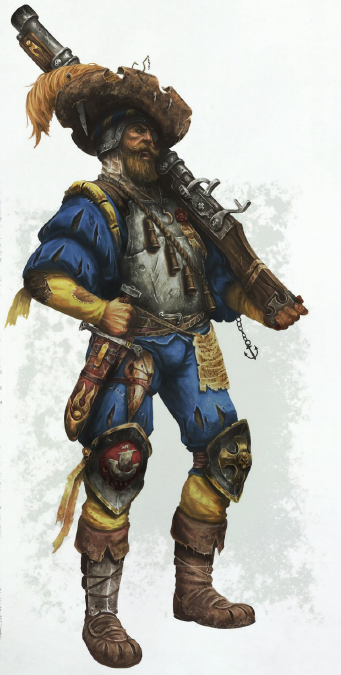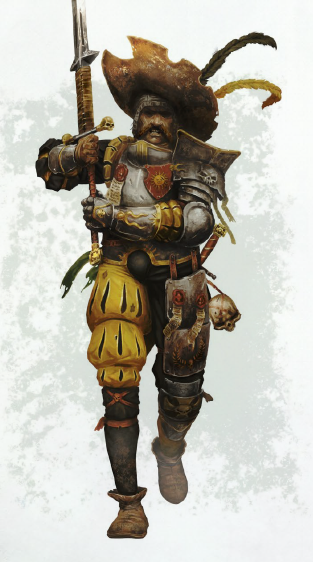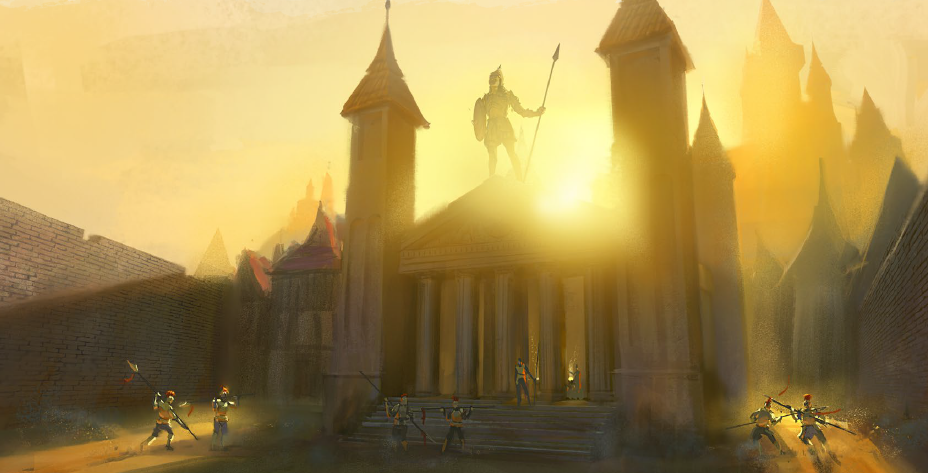This is a themed publication, providing various information on the art of soldiering in the WFRP. Specifically we get sections focused on careers – Soldiers, Knights and Mercenaries; a short section on Tilea; an extensive chapter on the Cult of Myrmidia; and then lots of new rules including alternate rules for injuries, mounted combat, chases, artillery, hirelings and group advantage.
I’m quite fond of these sorts of books – a variety in chapters, which keep my attention, but with a theme tying everything together such that they don’t feel too disparate. I think Up in Arms is pretty good example.
Warriors
The new career chapters are a mixed bunch. I love Careers as much as the next WFRP fan, but I do find it hard to judge their value. Partly this is because by this stage I really can’t be bothered to cross reference all of the multitudinous talents to remind myself of what each one does.
But beyond that, do we really need different careers for soldiers armed with handguns, soldiers armed with bows, soldiers armed with halberds and soldiers armed with greatswords? They do have slightly different advance schemes, talents and skills, so arguably yes we do. I’m more certain of the value of the Camp Follower (an absolute classic “crap WFRP career”, sitting comfortably alongside such WFRP staples as the Bawd, Grave Robber and Ratcatcher) and the Cartographer. The Artillerist is one of those careers that is a little harder to work out how one would fit into an adventuring party, but it’s certainly distinct. There’s a whole chapter near the end of the book with rules for firing artillery and damaging structures for them to use.


Regardless, arguably the best bit of the career chapters are the descriptions of how each career operates in the Empire and how they might take up adventuring. These descriptions are given more space compared to the core book careers (a double page for each career instead of just one) and there are some fantastic bits of lore in here, even adventure hooks.
The Knight chapter is much the same, perhaps the best bit being a list of the Knightly Orders of the Empire with their defining characteristics. (Although there’s also a fun section where a Dwarf Armourer makes disparaging comments on the quality of human armour.) We get careers for Freelances (i.e. unaffiliated knights) plus Knights of the White Wolf, Knights of the Blazing Sun and Knights Panther. (Presumably other Knightly Orders have to make do with the standard Knight career.)
The Mercenaries chapter is an odd one. Part of it seems to stealthily be a short introduction to Tilea; then we get three careers (Siege Specialist, Pikeman, Light Cavalryman) which feel like they could have been included in the Soldiers chapter earlier. We quickly move on to the Tilea chapter.

My favourite nation and an interesting deity
Tilea is one of my favourite nations of the Old World, in spite of the fact that I know almost nothing about it, since Games Workshop have published very little on the region. At just 11 pages, this chapter does not do a great deal to change that! We get a welcome but very brief overview of the region and its city states; we get a gazetteer which is interesting, but arguably not the best use of 3 whole pages. We get a couple of pages of playing Tilean characters (including their skills and talents, some minor changes to careers, and a names list). And we get 4 pages of a Tilean timeline; again, this is very interesting, but I really felt that we could have done with less history and much more information about what Tilean is like now and what it means to be a Tilean (whether living in Tilea, or an expat living in the Empire).
Probably my favourite chapter of the book is on the cult of Myrmidia. I remember reading about Myrmidia in the First Edition rulebook and thinking she was a bit pointless (given that Ulric and Sigmar exist). Since reading Second Edition’s Tome of Salvation, my opinion has changed completely and I think she is a fascinating goddess: another point of religious tension in the Old World; an example of verisimilitude (why should there be only one war deity in the Old World?); a fascinating insight into the principal faith of both Tilea and Estalia; and indeed a deity of war with a distinctly different personality to that of Ulric. More detail on the goddess and her followers is extremely welcome.

I particularly enjoyed the “principal figures” section, which alongside the expected influential priests and prophets includes ancient writers of military tactics (including an Elf and Dwarf who predate the faith of Myrmidia itself!). I also really liked the discussions about the tensions between the cult of Myrmidia and other Old World faiths: the crossovers with Morr, Verena and Shallya in different ways and the obvious tensions with the faith of Ulric, Sigmar and Ranald. I think inter-faith tension is a really interesting source of conflict in the Warhammer world so it is really great to see some good material on it. And with Myrmidia you also get intra-faith conflict, since there is a major disagreement about whether the faith arose in Estalia or Tilea, so there’s plenty of interesting tension between those factions of the cult.
Rules stuff
There follow the rules chapters. I’m not inclined to go over these in great detail, just some observations.
There’s a big equipment chapter; these often send me to sleep, but the inclusion of background on weapons development in the Old World kept my attention. I appreciate the inclusion of different characteristics for swords, axes, maces and hammers; in simple First Edition it made a lot of sense to count these all as a generic “Hand Weapon”, but in rules-heavy Fourth Edition that feels like an out-of-place simplification.
There are rules for mounted combat which feel realistic, including some rulings about how you can guide a mount’s actions, and how the Skittish trait (e.g. in a horse) interacts with the training a mount has received. There’s also some information on Demigryphs (which I confess to having a bit of a soft spot for).


Rules for hirelings are a good thing for any party-based RPG (there’s always that time when no-one wants to play a healer or a rogue) and there’s a short chapter that gives some basic rules on how to add character to your hireling characters, including a list of physical quirks, personality quirks and (best of all) work ethic (which gives details about how much of a shirker your shiny new hireling will be).
There are more detailed rules on Pursuits, which slightly sent me to sleep, but I can imagine could be useful since they deal with the situations which the corebook’s rules are too simplistic to deal with.
The standout rules chapter is “Group Advantage”, which in only four pages overhauls the much-maligned Advantage system1. If you choose to use it (and by all accounts you should) then Advantage becomes a pool for each side in the combat, with new ways to generate it. Advantage is now spent from that pool by anybody on that side to perform various (up to the powerful “take an additional action”, which costs 4 Advantage). There’s even a modified list of Actions you can take in combat (for instance Charging no longer generates Advantage, it just gives you a +10 bonus to your first Melee test… rather like First Edition!)
There are various advantages (haha) to the new system. Most obviously it reduces the bookkeeping, since there is just one pool for the players and one for the GM, rather than one pool per player; and it should make combat less swingy, since just possessing Advantage gives no benefit; you have to spend (and thus lose) it to gain bonuses. Furthermore the new rules favour using skills to gain tactical advantage over simply winning (i.e. they generate more advantage) which will hopefully enable non-combat characters to feel like they can contribute more.
We also have some new endeavours and talents. Most of the talents are actually existing talents re-written to accommodate the changes to advantage. The endeavours are a bit more interesting and include various manoeuvres you can use once in the following adventure. Some are quite characterful, with names like ‘Fanmaris’s Perfect Shot’ and ‘The Leitdorf Defence’. There’s even one that generates a job (dealt with briefly via narrative) for the warrior to go on in order to find a particular piece of equipment; it’s quite flavourful, but I imagine many players might prefer to actually play this out as an adventure (in which case of course the job generator provides a barebones outline).
Conclusion
I wasn’t sure about buying Up in Arms. I commonly think of Warrior careers as some of the least interesting in RPGs and the prospect of a big list of weapons, or yet more combat-focused talents, did not thrill me. I think the book has thoroughly exceeded those expectations. As usual for Cubicle 7 it features absolutely stellar artwork combined with great writing, both which really serve to bring the Warhammer world to life. There is a LOT in this book that will serve any GM who wants to run a campaign with any kind of military setting, such as with PCs as soldiers or mercenaries or simply interacting with the military as part of an adventure. Equally, players of Soldier, Knight or Mercenary characters, or any followers of Myrmidia, will find loads of useful information in here to help them roleplay their PC.
It is definitely a shame not to get more on Tilea – I would love a whole book on this fascinating nation – but it is nice to get something, and the opportunity to play a Tilean character is a really nice bonus.
To top this off we have the inclusion of plenty of rules for situations that could easily come up in WFRP adventures. Naturally the Group Advantage rules are the standout, but there are some other good bits and pieces here and there.
Buy Up in Arms from DriveThruRPG. This is an affiliate link so I receive a small payment for purchases made using it.
- Covered in the first part of my review of the Fourth Edition Rulebook here ↩︎

I actually don’t own this book and probably never will unless i come across it in a car boot sale or charity shop. It’s one of those books that I looked and and said to myself ‘Will you ever use any of this stuff?’ and answered myself ‘Nah!’
There are a number of these fragmented rulebook supplements that have come up like ‘Winds of Magic’ and Sea Of Claws’ where I look at the cost and and think about the value of the content and just decided to pass.
I can play the game without them.
LikeLike
Fair enough. I thought it was worth the price of admission, especially for the Myrmidia stuff, as well as the hirelings info and of course group advantage.
LikeLike
I don’t use Myrmidia very much in my game as she is really a minor god in my game and there are existing rules for hirlings and the like. I went through the contents list and listened to a few reviews and decided there was nothing there I needed. I’m more interested in sourcebooks but then only if they are consistent with existing lore. Too many of the new ones just create more work to sort out the inconsistencies.
LikeLike
For more information on Tilea, you might want to try and get hold of a copy of the WFB 5th edition Dogs of War army book. It goes for quite a bit on Ebay these days, but as far as I’m aware it’s the most comprehensive official source on Tilea.
LikeLiked by 1 person
Thanks for the advice. I have got the fan-made Warhammer Armies book on Dogs of War as well as the Spears of the Maiden (2nd ed WFRP) fan creation, but I haven’t read either of them yet. I shall have to make time!
LikeLike
I also have the Spears of the Maiden document but haven’t read it. I’m not familiar with the fan-made Dogs of War book – I assume it’s for a later edition? If I track it down I can see how it compares to the official book.
LikeLike
It’s from the Warhammer Armies Project which is a fan project updating Warhammer Fantasy Battle to 9th edition: http://warhammerarmiesproject.blogspot.com/
LikeLiked by 1 person
I’ll check it out!
LikeLike
I’ve just done a quick side-by-side comparison of the 5th and 9th edition Dogs of War books, and it looks like the background section of the latter is copied more or less word for word from the former.
LikeLike
Thank you. That is nice to know!
LikeLiked by 1 person
Pingback: Review: Fourth Edition Rulebook (Part 1: System) – Ill Met by Morrslieb
Pingback: WFRP 4e: State of the Line – Ill Met by Morrslieb
Pingback: Interview with Simon Wileman – Ill Met by Morrslieb
Pingback: Interview: Anthony Ragan – Ill Met by Morrslieb